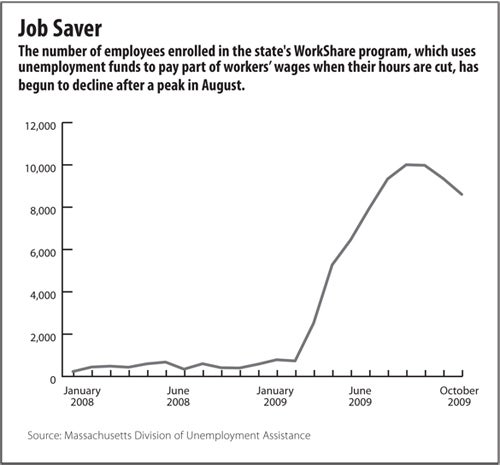In what could be a sign that manufacturing employment levels are stabilizing, a state program that helps employers keep workers on the payroll despite a drop in business is seeing a decline in participation.
The Massachusetts WorkShare program uses unemployment funds to pay part of workers’ wages when their hours are cut.
As the economy declined during the recession, its popularity skyrocketed, particularly among manufacturers who wanted to retain trained employees and bring them back to full hours when orders picked up.
In January 2008, 16 companies and 165 employees across the state took part in the program. By July 2009, the numbers had risen to 446 employers and 9,939 workers.
Since then, though, participation has crept back down. In October, 449 companies were in the program, but they had only 8,539 workers participating.
Leading Indicator?
Edward T. Malmborg, director of the state Division of Unemployment Assistance, said it’s not entirely clear why the numbers are going down.
He said he thinks many employers may have been able to bring workers back up to full-time status, but the state doesn’t keep track of what happens to workers who leave the program.
Jack Healy, director of operations at the Massachusetts Manufacturing Extension Partnership, said manufacturers may be bringing some people back to full-time status and letting others go entirely.
For most companies, he said, the state requirement that they continue providing benefits to employees who are in the program means they have to bow out at some point.
“They can last for a while, but they can’t last for an indefinite period,” he said.
State employment numbers suggest the decline in use of the program doesn’t reflect an overall turnaround in manufacturing employment.
On a seasonally adjusted basis, total manufacturing employment in the state has slid continuously downhill for more than a year, from 284,000 in September 2008 to 267,000 in September 2009.
Work Around
Of course, the number of people in WorkShare hasn’t fallen to anywhere near pre-recession levels yet, and many companies remain heavily involved in the program.
In Athol, the L.S. Starrett Co. cut its local manufacturing workers’ hours and started working with WorkShare more than six months ago.
Lately, personnel director Joel Shaugh-nessy said, the company has seen a little pickup in business, but it’s kept essentially the same number of people in the program.
“Some people went back to 40 hours, then back to WorkShare a month later,” he said. “It’s little pockets of little increase here, little increase there.”
But no matter how many employees end up on the WorkShare program or how long they stay there, Malmborg said the state will keep offering the program.
He said companies’ use of the program can count against their accounts in the unemployment program, meaning that they will have to pay more in future years.
In the meantime, the Massachusetts unemployment trust fund is expected to reach insolvency in December, but Malmborg said unemployment benefits — including WorkShare benefits — will continue to flow from the federal reserve fund.
“This is a part of the plan,” he said. “The employers who choose to enter the program can continue to do that. There is no way that the program would be stopped.”

